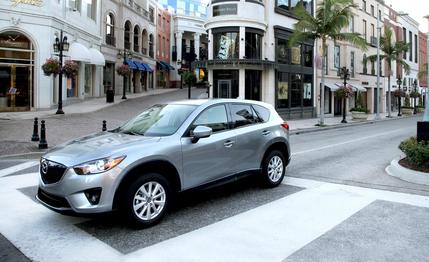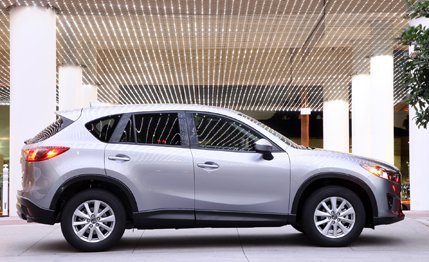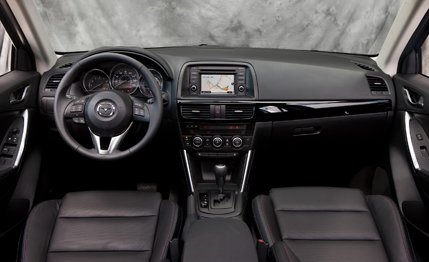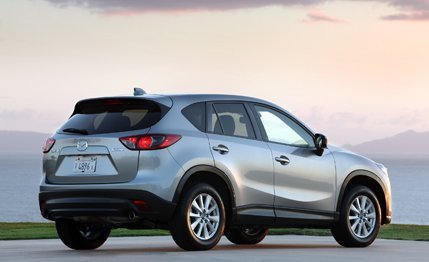 First Drive Review
First Drive Review
Absolute power might corrupt absolutely, but a little more of it never hurt. In fact, sometimes it can be a big help. Case in point: Mazda’s CX-5. Since its debut as a 2013 model, the CX-5 has impressed us with its styling, assembly, comfort, utility, fuel economy, and, in particular, dynamics. We’ve characterized that aspect of this compact crossover’s persona as “compelling,” and it helped the utelet to a comparison test victory over five other small SUVs. But the Mazda has also provoked uniform indifference for its tepid power. As we observed in the initial report on our CX-5 long-term test subject, “no logbook comment fails to mention its slowness.”
Power vs. MPG
The CX-5 was the first full manifestation of Mazda’s so-called Skyactiv Technology, a holistic approach to design focusing on weight reduction, efficiency, and mpg. Power is supplied by a 2.0-liter DOHC direct-injected aluminum four, and there isn’t a whole lot of it: 155 horsepower, 150 lb-ft of torque.
Hitched to a 3500-pound crossover with a six-speed automatic, this yields very good fuel-economy ratings from the EPA—25 mpg city/31 highway with all-wheel drive—but acceleration is, to be kind, uninspiring, with 0-to-60 mph in 9.2 seconds and a quarter-mile sprint in 17.1 seconds at 81 mph, according to our instrumented test runs.

The engineering challenge: Pare seconds off those dismal times without excessive mpg sacrifice. The answer: a new 2.5-liter four for the CX-5’s top two trims, one shared with the new Mazda 6 sedan. This one offers 184 horsepower and 185 lb-ft of torque.
An undersquare design (89-mm bore, 100-mm stroke), the new 2.5 has some interesting engineering details. Its compression ratio is race-engine high at 13:1, but as with the 2.0-liter four, the 2.5 operates on regular unleaded fuel. Also, as a member of the Skyactiv G engine family, it’s assembled on a line that can accommodate four-cylinder engines that can range from 1.3 to 2.5 liters. What makes this unusual is that the bore centers differ slightly from one displacement to another.
Speaking of race-car touches, the new exhaust manifold is reminiscent of the old “bundle of snakes” on the Ford GT40. That tangle of tubing that looks like Medusa on a good hair day helps net optimal efficiency—and quick catalyst light-off.

Price and Payoff
Based on a half-day drive in the Texas hill country around Austin, it seems as if the Mazda powertrain team has hit its marks. We estimate 0-to-60 times for 2.5 AWD models in the 8.3-to-8.4-second range—not exactly nosebleed territory, but a nice improvement over the 2.0. And in the real world, it amplifies the CX-5’s exemplary responses, enhancing corner exits, reducing passing exposure time on two-lane roads, and lending more verve in the daily stoplight derby. Just as important, the 2.5 maintains EPA fuel-economy ratings near the top of this class: 25 city/32 highway with front-wheel drive and 24/30 with all-wheel drive.
But there are asterisks. For example, the 2.5-liter is offered only with the six-speed automatic transmission. The 2.0 can be linked with a six-speed manual gearbox, but that engine and the manual option are limited to the base (Sport) model. And the premium for the 2.5’s extra punch is a bit over $2000, although this is a little misleading, since the 2.5 is confined to the upscale Touring and Grand Touring models. Both of those have the larger engine and automatic transmission as standard equipment, with the mid-level Touring also including as standard a backup camera, a power driver’s seat, blind-spot monitoring, a leather-wrapped steering wheel and shifter, fog lamps, a premium audio system, a split-folding rear seat, and Bluetooth.

In addition to the 2.5-liter four, the 2014 CX-5 receives a number of small detail and equipment updates. Most significant among these is Smart City Brake Support, which uses laser technology to monitor closing rates and ultimately prevent low-speed (up to 19 mph) collisions by applying the brakes should the driver fail to respond to system warnings.
Pricing on models equipped with the 2.5-liter opens with the $25,410 front-drive Touring model. All-wheel drive raises the cost to $26,660, and the top-of-the-line Grand Touring starts at $28,415. A GT with AWD runs $29,665.
How important is a second or so to 60 mph? Is it worth the extra cost? You obviously have to answer that question for yourself. But we can say that the added power that comes with the new 2.5 makes the CX-5’s acceleration consistent with its other dynamic traits. Which adds up to a much more satisfying CX-5.